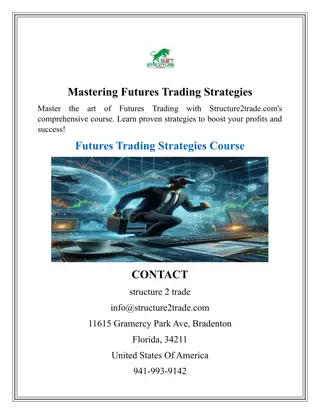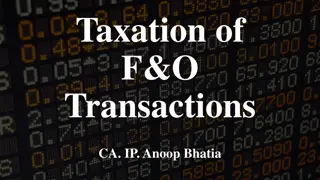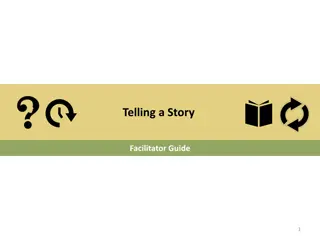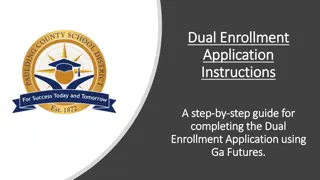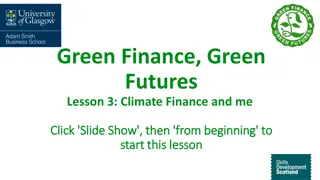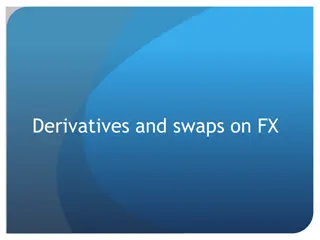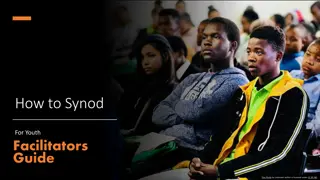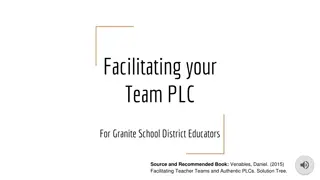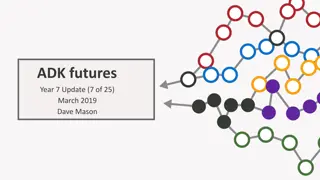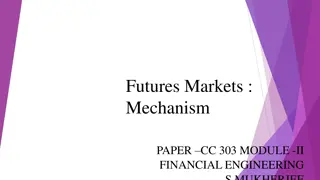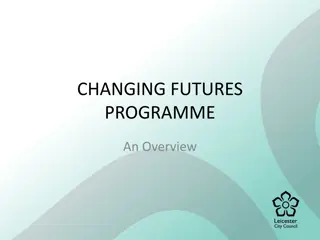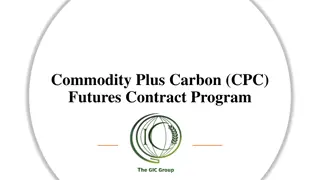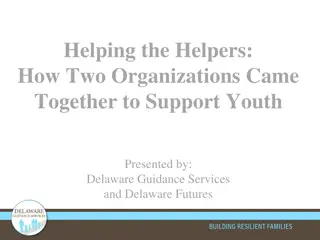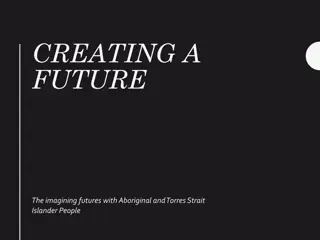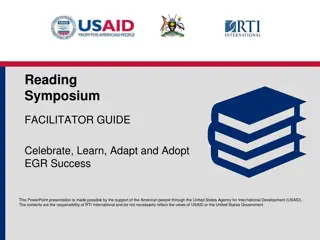Envisioning Potential Futures Facilitator Guide
This facilitator guide provides a structured exercise for participants to think across time, envision various future scenarios, and consider actions to shape those futures. The exercise consists of two phases focusing on understanding current issues, exploring potential futures, and strategizing actions. Participants will enhance their long-term thinking, decision-making skills, and the ability to anticipate future outcomes.
Download Presentation

Please find below an Image/Link to download the presentation.
The content on the website is provided AS IS for your information and personal use only. It may not be sold, licensed, or shared on other websites without obtaining consent from the author. Download presentation by click this link. If you encounter any issues during the download, it is possible that the publisher has removed the file from their server.
E N D
Presentation Transcript
Envisioning Potential Futures Facilitator Guide 1
Envisioning Potential Futures Facilitator Guide Purpose of Exercise This exercise provides participants with practice in thinking across time and anticipating how situations could evolve into the future. A second phase of the exercise provides practice in considering actions that can be taken to shape the future toward a desired scenario. Estimated Run Time If the exercise is conducted following the timing provided in the script, it will require approximately 4-3/4 hours [approximately 3-1/4 hours (Phase 1); 1-1/2 hours (Phase 2)]. 2
Envisioning Potential Futures Facilitator Guide Summary of Exercise In Phase 1, participants: Read a brief description of an emerging global hotspot. Consider a range of factors and sketch their understanding of the problem. Think back in time 5 years and describe the conditions that existed at that time. Think forward in time and describe alternative futures (preferred, probable, possible). Work in small groups to present and discuss their work. In Phase 2, participants: Focus on a single future scenario, selected by the facilitator. Generate ideas about how to shape the future to align with the selected scenario. Consider 2nd- and 3rd-order effects of chosen actions. Reflect and discuss in a group setting. 3
Envisioning Potential Futures Facilitator Guide Learning Objectives Participants will learn to: Appreciate the value of thinking beyond the present and/or near-term future. Recognize that current assumptions, decisions, and courses of action can have long-term implications. Recognize that thinking back in time (historically) can support the ability to anticipate how the situation may evolve into the future. Consider a range of factors and their interactions when making sense of a current situation and anticipating potential futures. Envision and create descriptions of potential futures. Consider how to shape conditions in a way that leads toward the desired future scenario. Relation to Other Exercises This exercise is best used after participants have completed the following exercises: Reflecting on the Environment, Asking Powerful Questions, and Telling a Story. The skills addressed in those exercises are important building blocks for conducting the activities in this exercise. Group or Individual Activity 4 This exercise includes activities that require a combination of group and individual work.
Envisioning Potential Futures Facilitator Guide Materials Needed (Facilitator) Brief written description of a situation/problem that is relevant to the Army (see associated materials for five examples) Whiteboard and markers One Participant Guide for each participant Expert perspective videos (viewable in the Managing Complex Problems Resource: Expert Perspective Videos page, filter by Envisioning Potential Futures) Materials Needed (Participants) Participant Guide Pen/pencil Notebook or paper 5
Envisioning Potential Futures Facilitator Guide Facilitator Tips and Guidance Remind participants: There is no right answer, or correct version of the future that they need to figure out. The exercise is more about thinking and projecting into the future than about what the Army should (or should not) do. The exercise has an inherent uncertainty built into it given the requirement to describe future conditions. The ambiguity and uncertainty that is part of the exercise is part of what happens in real-world, operational environments. Intersperse the pre-, mid-, and post-exercise reflection discussions with videos on the topics of foresight and thinking in time (viewable in the Managing Complex Problems Resource) 6
Envisioning Potential Futures Facilitator Script Instructions The next several pages provide step-by-step instructions for facilitating the exercise, broken down into modules. Each module includes icons to indicate its duration, DO: facilitator actions, SAY: facilitator talking points, and DISCUSS: questions for group discussion (see below for icons). While the talking points are simply intended to guide the facilitator, we recommend including them to achieve the intended learning outcomes. Talking points that are listed directly under an action are meant to assist the facilitator with that given action. Also, optional break points are indicated at the end of certain modules. Some modules also include clickable links to the exercise slide deck that supplement the facilitator guide. We recommend referring to the accompanying slide content while guiding your group through this exercise. Module SAY DISCUSS DO Duration 7
PHASE 1: ANTICIPATING PROBABLE AND POSSIBLE FUTURES 8
Step Facilitator Activity 1 Exercise Set up DO - Distribute and describe Participant Guide. SAY - - 30 min Today we are going to practice our strategic foresight skills. This guide contains information that you will use throughout the exercise. I ll let you know when you need to turn to a particular section. Also, you can take this with you after the exercise. DO - Conduct pre-exercise reflection. Direct participants to the Participant Guide and describe the task. SAY - Before we get started with the exercise, please flip to the Pre- Exercise Reflection section of your Participant Guide. DO - View Value of Envisioning Potential Futures Exercise and sampling of other expert perspective videos on foresight and thinking in time. Access through the Managing Complex Problems Resource: Expert Perspective Videos page, filter by Envisioning Potential Futures. 9
Step Facilitator Activity 1 Exercise Set up (contd.) SAY - For many of us, thinking beyond the present or near-term future, considering long-term implications of our decisions, and anticipating future circumstances is difficult. Take a few minutes to consider what is involved in visualizing how a current situation or problem may change over time and think about the questions listed there. Then, we will discuss them as a group. 30 min DISCUSS - Guide the group through a discussion using the following questions: - What about that activity seems fairly straightforward? What is difficult? - Are some problems or situations easier to play forward in time than others? What accounts for those difference? - What makes it difficult to anticipate second- or third-order effects of today s decisions and actions? DO - Provide brief tutorial. See supporting slides. - [Note: Facilitator may decide to present tutorial verbally, print the slides, project PowerPoint, or some combination thereof.] 10
Step Facilitator Activity 1 Exercise Set up (contd.) DO - Describe the exercise. SAY - 30 min In a few minutes, I ll be giving you a scenario description. In this exercise, we are going to think about the scenario in several different ways. Your first task is to develop an understanding of the situation as it currently exists. Then I m going to ask you to think back in time and consider how the situation might have come to be. After that, I m going to ask you to envision how the scenario might evolve in the future. You may find it pretty challenging to anticipate potential future scenarios without a lot more information. It may seem awkward or uncomfortable. Remind yourself that being able to anticipate potential future conditions in the midst of uncertainty is part of what we need to be able to do in real world operational settings, so it is important to practice. - [End of Step 1] 11
Step Facilitator Activity 2 Orient to Current Scenario [Note: To reduce in-class work, the facilitator may also conduct Step 1 in one session, ask participants to conduct Steps 2-4 outside of the classroom, and then regroup in another session for Steps 5-7.] DO - 30 min Ask participants to flip to the Developing an Understanding section of their Participant Guide. DO - Distribute the scenario; each participant should have his/her own copy. Describe what participants will do in this portion of the exercise. [Note: Five example scenarios are provided with this exercise. However, the exercise facilitator should consider creating additional scenarios based on current events so that the exercise can be repeated using different scenarios. See Facilitator Tips and Considerations for scenario development tips.] - SAY - As you read through the scenario, think about the nature of the problem it describes. We ll spend about 30 minutes on this part of the exercise. You ll work on your own for now. 12
Step Facilitator Activity 2 Orient to Current Scenario (contd.) SAY - You are going to work on two things: 1) An initial understanding of the situation described in the handout, and 2) a rough sketch that depicts your view of the situation. Use your notebooks for the sketch. Don t worry about making it look great, or like it s ready for a PowerPoint slide. The point of the sketch is to help you think about the situation and understand it. As you are thinking about the scenario, it s important to consider the whole range of factors that could be at play: the political, economic, cultural, environmental, and technological factors, as well as military factors and stakeholders. The Potential Factors to Consider box in your Participant Guide will help prompt your thinking. The sketch you come up with should represent your understanding of the scenario and include stakeholders, key factors, and relationships among those factors. You will brief this understanding to each other later on in the exercise. As you do this, it is important to recognize that there is no single right answer. There are many different ways to interpret and describe the situation. For now, the important thing is to consider and account for multiple factors and their interactions in your description and sketch. 30 min - - 13
Step Facilitator Activity 2 Orient to Current Scenario (contd.) DO - Check that all participants have a rough sketch before moving on with the exercise. [End of Step 2] 30 min 14
Step Facilitator Activity 3 Think Back in Time DO - Refer participants to Timeline: Part 1 in their Participant Guide. DO - 30 min Ask participants to think back in time by five years and describe conditions and relationships that existed then. [Note: Sometimes participants get stalled at this point and have difficulty moving forward with the exercise because they don t have a lot of information to work with. If this happens, consider letting the group have a 5-10 minute discussion about the situation represented in the scenario. The discussion should focus on sharing facts and knowledge that group members have about the situation, to provide a common base of knowledge.] - SAY - Now we are going to think back in time. I d like you to imagine it is five years before the current situation described in the scenario. In other words, if we were here (at the current situation), I would like you to take that current situation and rewind it by five years. What did the situation look like at that point in time? 15
Step Facilitator Activity 3 Think Back in Time (contd.) SAY - Work individually to think through and describe the conditions and relationships that existed five years prior to the current situation. Record your thoughts in your Participant Guide or notebook using both words and sketches. Again, there are no right or wrong answers. The situation as it existed five years ago can be interpreted and described in many different ways. I recognize that you do not have all the information. Normally, you would likely gather additional information to help you understand the history. Do your best to fill in the gaps. Then I d like you to jot down three to five key questions things that seem critical to know and then create some answers or assumptions. Use those answers or assumptions to move forward with the next part of the exercise. 30 min - - [End of Step 3] 16
Step Facilitator Activity 4 Envision Future Scenarios DO - Refer participants to Timeline: Part 2 in the Participant Guide. DO - Ask participants to consider a probable scenario two years into the future. [Note: Once participants gain experience in thinking two years out, the facilitator should challenge them further by lengthening the time horizon e.g., consider the situation five years out, ten years out. When doing this, participants should think back in time twice as long as they think forward in time e.g., think back ten years to think forward five.] 25-30 min - SAY - So far, you have developed an initial understanding of the current situation provided in the scenario description. You have also considered what the situation might have looked like five years prior to today. Now we are going to think forward in time. Working individually, and based on your understanding of the current situation and how it may have developed, we are going to consider what the situation might look like two years from now from a couple of different perspectives. - 17
Step Facilitator Activity 4 Envision Future Scenarios (contd.) SAY - Please turn to the section of your Participant Guide titled Timeline: Part 2. This will help orient you to the time horizon we re considering. Given that there could be a variety of potential future situations, I d like you to first think about a scenario two years out that is probable. Based on your current understanding of the situation, what situation will we likely see in two years? We re only going to spend five minutes on this because the probable scenario is likely the first and easiest scenario to consider. Probable scenarios tend to reflect incremental changes and a gradual evolution of circumstances, rather than a more dramatic disruption that substantially changes the course of events. - 25-30 min - DO - Ask participants to consider and write a description of a possible scenario two years into the future. SAY - Now we re going to think about a potential future scenario that may be unlikely but is possible. 18
Step Facilitator Activity 4 Envision Future Scenarios (contd.) SAY - We re going to spend about 15 minutes considering what the situation could possibly become two years from today. Take some time to think about this possible scenario, then write a brief description of it and/or sketch it out. You may jot down notes or bullet points if you prefer. Later in this exercise, you will be presenting these possible future scenarios to one another. There is no right or wrong answer to this, but we should be able to see connections between the current situation, its history, and the possible scenario you develop. 25-30 min - [End of Step 4] - BREAK - 19
Step Facilitator Activity 5 Mid- Exercise Reflection DO - Refer participants to Mid-Exercise Reflection in their Participant Guide. DO - 15 min Ask participants to take 10-15 minutes, working individually to consider the questions listed there and write notes in response. [End of Step 5] 20
Step Facilitator Activity 6 Present Scenarios DO - Form small groups of three to four people. Inform participants that they will present their understanding of the current situation and envisioned possible future to the others in their group. [Note: They can self-form the groups, or you can count off to determine group membership.] 30 min - SAY - Your task is to present two things to your small group: 1) Your understanding of the current situation depicted in the scenario description you were given at the beginning of this exercise, and 2) the possible future situation you envisioned. Each person should take approximately five minutes to present their work and sketches to their group. I encourage you to ask each other questions and comment on one another s briefings. - DO - Refer participants to the Small Group Discussion questions listed in the Participant Guide. Encourage participants to identify and discuss similarities/differences in the possible futures they envisioned. - 21
Step Facilitator Activity 6 Present Scenarios (contd.) SAY - Consider that you all started in the same place, with the same scenario. How similar are the potential futures you came up with? Within your group, explore and discuss why/how you came to different places with your envisioned future scenarios. - 30 min [End of Step 6] 22
Step Facilitator Activity 7 Reflection and Debrief DO - Reconvene into one large group. DO - Refer participants to Group Debrief in their Participant Guide; ask them to consider the questions individually. 25 min DISCUSS - Guide the group through a discussion using the following questions: - In what ways are the possible futures envisioned by your group similar? In what ways are they different? - Consider and discuss how or why you came to different places with your scenarios. For example: - What do you see as the most significant factors that might influence the future scenarios? And why? - Were the factors you considered different from those considered by others in this group? How so? - What assumptions did you make in developing the two future scenarios? How were those assumptions different from the assumptions of others in this group? - What might account for the different factors you considered? Or for the different assumptions you made? 23
Step Facilitator Activity 7 Reflection and Debrief (contd.) DISCUSS [Questions contd.] - Now that you have discussed your considerations with others in your group, have you detected any blind spots you might have had when envisioning your possible future scenario(s)? What are they? How might you avoid those blind spots in the future? 25 min [End of Phase 1] - BREAK - [Note: We recommend practicing Phase 1 multiple times on different occasions, before proceeding with Phase 2. Facilitators should give participants a different scenario each time.] 24
PHASE 2: SHAPING THE FUTURE Note: Phases 1 and 2 can be conducted on different days or in different sessions. This will give the facilitator time to choose (or create) a scenario to use. 25
Step Facilitator Activity 1 Consider Potential Actions SAY - In this next phase, we are going to work with one of the future scenarios developed in the previous phase. We are going to consider initiatives, courses of action (COA), and strategies to pursue in order to shape the future in a way that aligns with a desired future scenario. 30 min DO - Select one possible future scenario developed by a participant in Phase 1. [Notes: Post the description with main points and sketch on a projector, whiteboard, or other common point of reference. Then describe scenario to participants. The scenario selected should be one that appears favorable to U.S. interests, based on the facilitator s judgment. The scenario chosen should be sufficiently rich and complex to spur thinking, diverse idea generation, and discussion. Potential variation: Facilitator develops his/her own possible future scenario and sketch for this part of the exercise.] - 26
Step Facilitator Activity 1 Consider Potential Actions (contd.) SAY - Here is the premise: The Army has received direction from higher command that this [posted] future scenario is in the U.S. s best interest. You are responsible for shaping the future in a way that enables the U.S. to realize the envisioned future situation. Your task is to develop ideas for how to maximize the likelihood of realizing this future situation. - 30 min DO - Refer participants to Shaping the Future in the Participant Guide. Direct participants to work individually and to use the questions listed in this section of the Participant Guide to help them generate ideas. - SAY - Spend about 20-25 minutes working individually and generating ideas in response to the Shaping the Future questions. The overarching goal is to generate ideas and recommendations for how to shape the future in ways that allow us to achieve the envisioned future described in the scenario. 27
Step Facilitator Activity 1 Consider Potential Actions (contd.) SAY - This is a brainstorming activity. The goal is to generate all kinds of ideas. Think broadly about all potential things the U.S. could do to get us to the future scenario. After this activity, you ll work in small groups and present your ideas. 30 min [End of Step 1] 28
Step Facilitator Activity 2 DO - - Idea Briefing Form small groups of three to four people. Ask participants to brief their ideas and recommendations to their small group. 30 min SAY - Share your responses to the Shaping the Future questions and brief your recommendations for how to shape the future in a way that enables the U.S. to bring about this desired future scenario. This is the time for building on ideas, rather than critiquing. As each person shares their responses, others should ask questions or provide comments that build on the ideas being presented. - DO - Refer participants to Ripple Effects in their Participant Guide. SAY - Now I d like you to consider and discuss the potential effects of your recommended approach on multiple factors such as individual or groups of stakeholders, economic factors, political factors, etc. Consider possible second- and third-order effects and unintended consequences as part of this discussion. [End of Step 2] 29
Step Facilitator Activity 3 Final Reflection & Debrief DO - Refer participants to Shaping Debrief questions in their Participant Guide. Ask participants to reflect on these questions individually. - 30 min SAY - Work individually and take 5-10 minutes to think about the questions posed under Shaping Debrief. As you re thinking about the questions, please write some notes in response. DO - Reconvene into the larger group. DISCUSS - Guide the group through a discussion using the following questions: - What assumptions did you make when developing your recommended course of action? - How might you test or verify those assumptions? 30
Step Facilitator Activity 3 Final Reflection & Debrief (contd.) DISCUSS - In this exercise, you were not held accountable for the accuracy of future circumstances that you envisioned, or for the ideas you developed for shaping the future. But when you use strategic foresight in real-world operational contexts, you will likely be held accountable. How might that expectation of accountability influence how you approach this activity in real operational settings? - Consider your initial understanding of the situation. How has your view of it changed based on this exercise? 30 min [End of Envisioning Futures Exercise] 31



